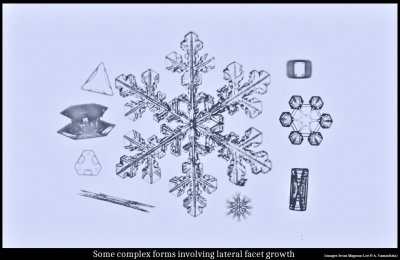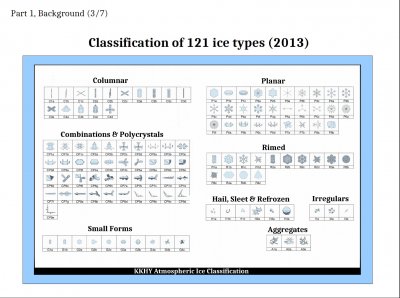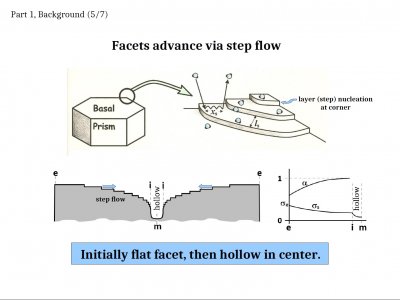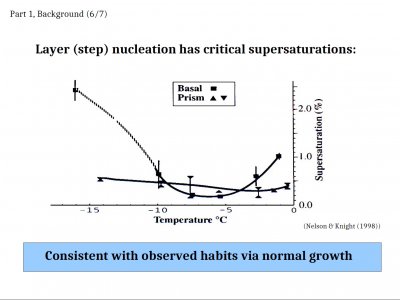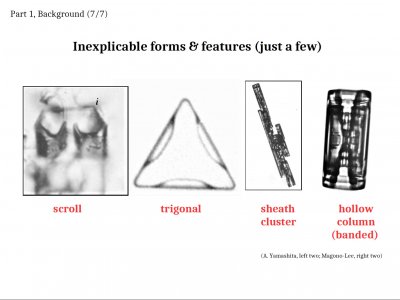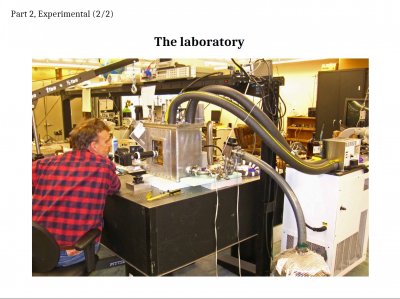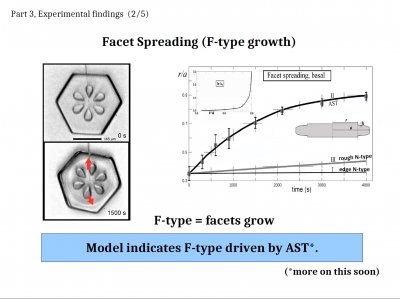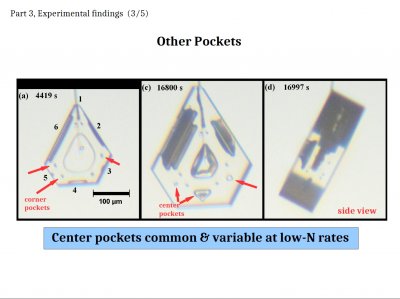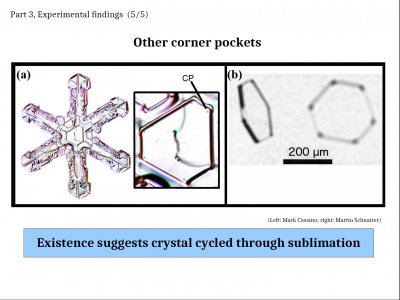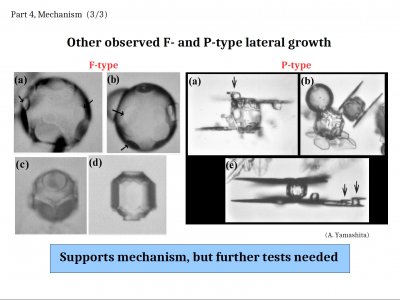| « The Curious World of Ice and Snow: Part 1 of 3 | The Growing Icicle's Hollow Tip » |
Some "Inexplicable" Snow-crystal Features: Applications of Lateral Growth
Last October, I gave a talk at the University of Washington about our recent experiments and ideas about snow-crystal growth. My pitch was general and short, as few folks work in this area and I'd hate to bore them with a long lecture. So, I was delighted to see quite a few graduate students in the audience, some of them asking good questions.
Instead of giving the narrated presentation here as a video, I will give the slides (23) with brief explanations similar to what was spoken at the talk. Narration below each slide. Skip to the ones that look interesting, and click on them to enlarge.
This experimental work was done with Brian Swanson of the UW, with funding from the NSF and Laucks Foundation. We did this work in the wonderful laboratory they have up there on Saltspring Island. The theoretical work was greatly aided by discussions with Akira Yamashita of Osaka Kyoiku University, and the paper publishing was possible with money from the Laucks Foundation and Gofundme.
Most of these crystals are from the classic Magono-Lee collection, a copy of which was given to me by Art Rangno (who was known as 'The Cloud Guy' here at the UW). You probably recognize some of the standard types, the dendrite, hollow column, and needle. The lateral growth mentioned in the title has implications for all of them, though we discuss only two here.
Ditto for the crystals here, which are from Wilson Bentley's first plate in his first research publication. Mr Bentley was a remarkable fellow who did a lot of early research on hydrometeors on his farm in Vermont, as well as other research including sunspots. In popular culture, he is known for his saying "no two alike" in regards to snow crystals and his extensive collection of snow-crystal photomicrographs. Note, here he calls them "microphotographs", which of course would be too tiny to see.
The researcher who has contributed the most knowledge about snow crystals was inspired by Mr Bentley. Ukichiro Nakaya is best known for his crystal habit diagram, which he made by being the first to grow artificial snow crystals in the laboratory. We will discuss a little about two forms here, their conditions shaded, the yellow for the scrolls and sheath and the blue for the dendritic. This is his other contribution to popular culture, the saying "A snow crystal is a letter from the sky."
Nakaya introduced one of the first snow-crystal classification schemes. I think it had 23 types. Here is the lastest, from 2013, with 121 types. It wasn't until 2013 that they put the most common ice type into the scheme, the aggregates, also known as snowflakes.
About how the crystals grow, the thing that researchers have long studied is the rate of advance of the crystal faces. We call this the normal facet growth, or N-type growth, the 'normal' part coming from the direction of growth being normal to the surface. Basically, this is the crystal getting larger.
How the facets advance has long been known to be due to the generation and lateral flow of steps. For example, this sketch showing molecules coming down at the corner and nucleating a new layer, the previously nucleated layers collecting more molecules and sweeping along the face. As these heights are much much less than their separation, the crystal faces appear perfectly flat. But at some point, the flow of steps breaks down, the steps clumping together. This happens first in the center, forming a hollow as shown in this bottom sketch. The quantities of interest, effectively the collection efficiency alpha, and the local deviation from equilibrium sigma-s, thus vary across the surface as shown in this plot.
What we found in earlier experiments was that, as long expected from theory, the critical supersaturations of the two faces essentially competed with each other, with the prism value lower above about -3 C, the basal value lower between -3 and -9, and the prism lower again below -9 C. The finding is consistent with the change of primary habit with temperature. Another interesting thing from these results is that the critical supersaturations are extremely low.
Those critical supersaturations and their connection to normal growth are very useful for explaining many observed features of snow-crystal habits. Yet, despite this success, some common crystal forms and features remained very hard to understand. These forms include the scroll here on the left, where these prism planes bend around, curling inward like a scroll of paper. Also, the trigonal form, the very common sheath cluster and hollow column, where the part that is inexplicable is this banding pattern.
We designed and built this apparatus, motivated mostly to study the normal growth rates. The challenge in using any crystal-growth device is to reduce as much as possible the artificial influences you have on the crystal's growth. One key thing is to not have the crystal contact anything. But if it is completely free-falling, then observation and manipulation become difficult. In the previous experiments that found the critical supersaturations, we came up with the capillary suspension in which the crystal hangs off the tip of an ultrafine capillary. This design here has three capillaries to allow us to do various other things as well. Other features we sought are listed here.
Here is the apparatus, with Brian behind the camera. Over here on the right is the chiller to set the environmental temperature and here is a vacuum pump. Some of the electronics are for heaters to set the supersaturation and thermistors to read the temperatures.
One morning I came into the lab and saw this nice crystal that had grown overnight. It had these six, thin, petal-shaped air inclosures in them. I sublimated the crystal a little, then regrew and noticed something in the crystal corners. In this first case, the corners just seemed to have a little blemish, and I would have dismissed it as such except it was odd to have the same blemish in the six corners. I repeated the sublimation-growth cycle and they came back more distinct as shown here. In fact, they are small air pockets in all 12 corners, as you can see at "7" in this slightly rotated view in (e).
We also saw the spreading of facets. The basal shows this spreading here, where the edge of the facet is marked by the red arrows. In this case, the growth is lateral, causing the facet to spread, growing in area. We tried a few models, as shown by the solid lines in this plot, and the one that fit best was the one with a process we called "AST", which we will describe soon.
So, we saw the corner pockets on any crystal that experienced a sublimation-growth cycle. Another type of pocket, which was quite variable in size and shape, is the center pocket, with several marked by red arrows in this middle image here. Center pockets have been observed by others and are actually quite common, although it is not known how they form.
But the corner pockets are very unusual. In fact, I had never noticed them before. Upon examinining the literature, I find a few cases, and in these cases, the authors never mention them either. It is as if their unexpected location had make them invisible.
A few more here, more recent examples: a crystal collected at the ground, here at the left, and one sampled in a cloud. As we had to sublimate the crystal first, we suggest that their appearance here indicates that the crystal underwent sublimation before returning to growth conditions.
About how some of these form, we turned to lateral-type growth. We can see dividing lateral-type growth into three types. The first, as you see here, is facet spreading, or f-type. The key thing we found is that this growth is driven by surface-mobile molecules that migrate over the edge of the facet and permanently lodge themselves into the facet "front". Following the suggestion of Akira Yamashita, we called this migration "adjoining surface transport" or AST. AST had been long argued to have a role in snow-crystal growth in this "standard" case in the middle, causing one face to grow faster or another to grow slower. In this case, one or both faces may be growing laterally, but we consider this trivial as it can also be described using normal growth. The bottom case was proposed by Akira Yamashita and called "protruding growth". The AST drives a thin protrusion of the top facet outward over the adjoining region. We also call this "p-type" for short.
As an example, we argue that the corner pockets must have formed from a sequence of f-type followed by p-type from both basal and prism faces as shown in this sketch. Sublimation is important for removing some of the edge region, which later becomes a pocket. Each of the 12 corners does this.
One can see both f-type and p-type growth in these images, so it is clear that these types of lateral growth occur.
The last images in particular help us to explain one mystery: the droxtal centers of some snow crystals. If you look at the center of the planar, branched type of snow crystal, such as the ones here, you will see on some of them, certainly not all, a small circle. Wilson Bentley noticed this in many of his snow-crystal images and suggested that they were the initial droplet around which the cystal formed. Such a just-frozen droplet is called a 'droxtal'.
The problem with his claim is that one needs to explain how the vapor molecules can crystallize in just one or two thin planes and not just fill out the droxtal. With p-type growth, it is easy to see how the perimeter of the droxtal can remain as the crystal grows as planar extensions from the top and bottom as shown here.
As all snow crystals are thought to originate on droxtals, it remains to be learned why this p-type growth would occur in some cases but not others. It appears that relatively large droxtals and relatively high supersaturations are more favorable to this type of growth, but an experimental study should be done to better understand it.
These types of planar extensions of the basal face, if instead applied to the prism faces, may help explain some other inexplicable growth forms: the scroll and sheath forms, as shown in these sketches.
With the prism p-type growth extensions, the growth may be along the c-axis or it may be normal to the c-axis. If it is just along the c-axis, then they lead to sheath crystals. But when they also extend normal to the c-axis as shown by the long arrow in this top left sketch, then the result can be a scroll. The proposed mechanism is as shown. As the extension spreads along p2, it thickens. Once the leading edge thickens sufficiently, it will facet, forming prism p3 here. Thus, the extension stops extending along p2, instead extending along prism p3. And so it goes, curling around.
A slightly different sequence is shown in the middle, but involves the same processes.
Finally, at the bottom, we can see how the sheath bundle can show sudden changes in diameter, despite forming in a temperature-supersaturation regime in which almost no normal prism-face growth occurs. In this case, the p-type extension overshoots the base crystal before curling around.
In this way, combinations of normal growth and lateral growth can explain a wide range of previously inexplicable growth forms.
Finally, the center pocket. In this case, the protruding growth occurs at the rim of the center hollow, causing it to form a lid, enclosing the air as a pocket.
We covered just a few examples here, but the main message is that the lateral-growth processes can help explain a wide range of crystal features and forms.
These and other cases are covered in our recently published paper, shown here. Although the research was paid through the NSF, the grant ran out before we published. So, we seek funds through GoFundme, details on my story of snow blog here. Thank you.
--JN
